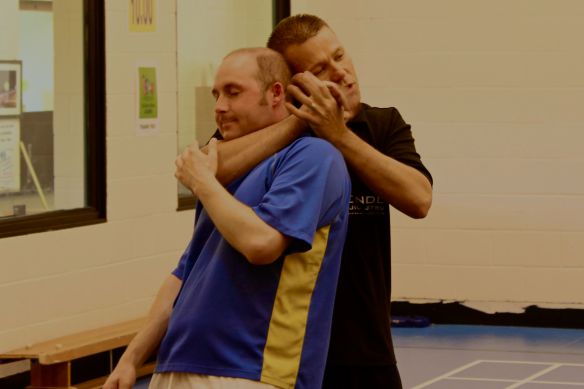The following is a slightly reworked version of my second column for Furniture & Cabinet Making (published in issue 227).

Clive Elliott demonstrates a blood choke on the hapless author.
The first time acclaimed martial arts instructor Clive Elliott demonstrated how to dislocate my spine, my woodworking improved significantly. No, really. Let me explain. While teaching a WWI combat system, Clive recounted how his Thai boxing improved after he started training in Silat, while his Kali weapons techniques were improved by his boxing body mechanics. The message was that practicing different arts with different focuses would help to improve your core skill set. Most of us are familiar with the idea of “transferable skills,” but what Clive was suggesting was something more subtle: “parallel skills.” So far, so brutal. But what, you ask, does this have to do with woodwork? Well, the more I thought about this idea of parallel skills, the more I saw something that could apply to both martial arts and woodwork.
So let me offer a suggestion and a challenge. To improve as woodworkers, we need to stop building what we ordinarily build and try something different.
Build Parallel Skills
I am not suggesting that we do not need to be proficient at building whatever our primary focus is; far from it. The foundation for any woodwork must be an understanding of the techniques to build your main projects. But after those fundamentals are understood, try something new. Because when you come back to your main area of focus, you may find that your skill set is much improved.

Cutting a tight dovetail uses a number of core skills
Here is why I think it works. The majority of woodworking operations are not skills by themselves but instead draw upon a range of core skills. When we talk about dovetailing what we are actually referring to is accurate marking out, sawing to a line, and chiselling to achieve a flat baseline. Practicing those skills will improve your dovetailing, and although there are practice exercises you can try, building a project is much more satisfying.

Paring the joint for the slipper heel, on an acoustic guitar neck in steamed pear
Focusing on parallel skills is an approach I have found to yield results. My focus is on lutherie, particularly acoustic guitars, although as regular readers will be aware, I have recently branched out into cabinet making with my Anarchist’s Tool Chest. And after just one project in a different field, my skill set has improved. When I build acoustic guitars I attach the neck to the body using the slipper heel (or “Spanish heel”) method, in which two slots are cut in the neck, into which the sides are wedged. This requires accurate sawing followed by precise paring to the baseline, and I covered this in more detail back in May. Before I went on the Anarchist’s Tool Chest course in July, I cut the slipper heel for my current acoustic guitar build. And because it is a joint I have done a number of times, I made a good job of it. After the course finished, I did the final tuning of this joint, and I was amazed to see that my chisel work and sawing had improved since I last cut the joint. What had caused this noticeable improvement? Cutting dovetails for five solid days on the course.

Gluing an acoustic guitar in a solera. Once the glue is dry the mahogany wedges will be trimmed to length and the back glued on.
Problem Solving
This is the second major benefit of trying a new area of woodwork. Think about it: whether you build Danish minimalist tables, lutes, or Shaker grandfather clocks, we all use wood. And unless you build something novel and cutting edge, most problems have been encountered before by others.

Dyed sycamore veneer between a birdseye maple neck and fretboard, on an electric guitar build.
Here’s an example: one of the things that crops up on guitar building forums is people getting in a tangle when using thin veneers, either as an accent line between other timbers, or as a face veneer on electric guitars. Ultimately they devise complex and ingenious solutions to do this. But if these guitar builders thought like an 18th century ebéniste, then they might find that a simple veneer hammer and press would be easier (and pose less risk to the household Dyson than a home-brew vacuum mould). Similarly, there are lutherie methods that translate to other fields of woodworking. When gluing up braces to acoustic guitar soundboards, I use a “go bar” deck – essentially bending thin strips of ash to fit into a space shorter than they are. The downward pressure of the go bars provides precise force, and is useful for any number of clamping tasks. I once read a woodwork book where the author explained how he parked his van on top of his work to get the necessary pressure, and although this apparently worked very well, it lacks the elegance of a go bar deck.

Using go bars to glue braces to an acoustic guitar soundboard
The Challenge
In throwing down this challenge I am not trying to tell anyone how to go about their craft. But, I hope I have shown there are benefits to breaking out of our comfort zones and trying something new. And I am happy to put my money where my mouth is. Although lutherie will continue to be my focus, my project list for 2015 includes building a trunk and maybe a pair of Roorkee chairs. And I have no doubt that my guitars will be all the better for it. So, what will you do that is different in 2015?










